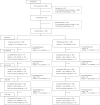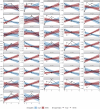Effect of sweeteners and sweetness enhancers on weight management and gut microbiota composition in individuals with overweight or obesity: the SWEET study
- PMID: 41057614
- PMCID: PMC12552123
- DOI: 10.1038/s42255-025-01381-z
Effect of sweeteners and sweetness enhancers on weight management and gut microbiota composition in individuals with overweight or obesity: the SWEET study
Abstract
Consumption of sweeteners and sweetness enhancers (S&SEs) is a popular strategy to reduce sugar intake, but the role of S&SEs in body weight regulation and gut microbiota composition remains debated. Here, we show that S&SEs in a healthy diet support weight loss maintenance and beneficial gut microbiota shifts in adults with overweight or obesity. In this multi-centre, randomized, controlled trial, we included 341 adults and 38 children with overweight or obesity. Adults followed a 2-month low-energy diet for ≥5% weight loss, followed by a 10-month healthy ad libitum diet with <10% energy from sugars. One group replaced sugar-rich products with S&SE products (S&SEs group), while the other did not (sugar group). Primary outcomes included changes in body weight and gut microbiota composition at 1 year. Secondary outcomes included changes in cardiometabolic parameters. The S&SEs group, compared to the sugar group, maintained greater weight loss at 1 year (1.6 ± 0.7 kg, P = 0.029) and exhibited distinct gut microbiota shifts, with increased short-chain fatty acid and methane-producing taxa (q ≤ 0.05). No significant differences were observed in cardiometabolic markers or in children. Overall, our findings indicate that prolonged consumption of S&SEs in a healthy diet is a safe strategy for obesity management. ClinicalTrial.gov identifier: NCT04226911 .
© 2025. The Author(s).
Conflict of interest statement
Competing interests: A.R. has received honoraria from Nestlé, Unilever and the International Sweeteners Association and is currently employed by Novo Nordisk. J.C.G.H. and J.H. have received project funds from the American Beverage Association. T.L. works for a company (NetUnion) that has no conflict of interest in the trial outcome. C.E.H.’s research centre provides consultancy to, and has received travel funds to present research results from, organizations supported by food and drink companies. The remaining authors declare no competing interests.
Figures









References
-
- Smith, K. & Smith, M. Obesity statistics. Prim. Care43, 121–135 (2016). - PubMed
-
- Fruh, S. Obesity: risk factors, complications, and strategies for sustainable long-term weight management. J. Am. Assoc. Nurse Pr.29, S3–S14 (2017).
-
- World Health Organization. Use of Non-Sugar Sweeteners: WHO Guideline (2023).
Publication types
MeSH terms
Substances
Associated data
LinkOut - more resources
Full Text Sources
Medical

